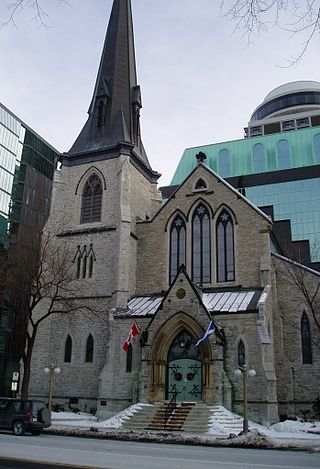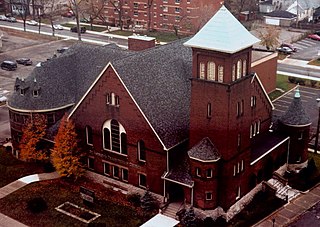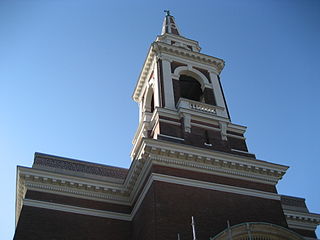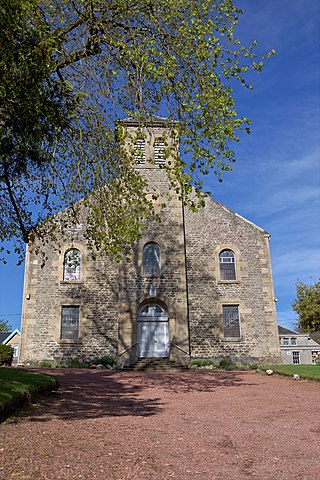The United Free Church of Scotland is a Scottish Presbyterian denomination formed in 1900 by the union of the United Presbyterian Church of Scotland and the majority of the 19th-century Free Church of Scotland. The majority of the United Free Church of Scotland united with the Church of Scotland in 1929.

St. Andrew's Presbyterian Church is the oldest Presbyterian church in Ottawa, Ontario, Canada.

The Presbyterian Church in Canada is a Presbyterian denomination, serving in Canada under this name since 1875. The United Church of Canada claimed the right to the name from 1925 to 1939. According to the Canada 2001 Census 409,830 Canadians identify themselves as Presbyterian, that is, 1.4 percent of the population.
The Presbyterian College/Le Collège Presbytérien, 3495 University Street, Montreal, Quebec, is a Theological College of the Presbyterian Church in Canada, and is affiliated with McGill University through its School of Religious Studies. The Presbyterian College's student base comes from across Canada and around the world.

St. Matthew's United Church is a United Church of Canada church in downtown Halifax, Nova Scotia. The church was founded at the same time as the original colony in 1749 as a home for the various groups of dissenting Protestants who were from New England and who did not follow the Church of England. It originally met Sunday afternoons in St. Paul's Church, the Church of England building completed in 1750. The church got its own home in 1754 when a church was constructed at Hollis and Prince streets. This building was destroyed by fire in 1857, and a new church was built at the current location at 1479 Barrington Street, land parcelled off of the Black-Binney House estate by Bishop Hibbert Binney. The church used the Old Burying Ground.

St. Andrew's Church is a historic Presbyterian church located at the corner of King Street West and Simcoe Street in the city's downtown core of Toronto, Ontario, Canada. It was designed by William George Storm in the Romanesque Revival style and completed in 1876.

Knox Presbyterian Church is a Presbyterian church in downtown Toronto, Ontario, Canada.

St. Andrew's Presbyterian Church is a Presbyterian church congregation located in Quebec City, Quebec, Canada. It belongs to the Presbyterian Church in Canada denomination.

St. Andrew's Presbyterian Church, is a Presbyterian Church in Canada congregation in downtown Windsor, Ontario, Canada. The congregation dates back to 1857, and at one time, was the largest congregation by membership within the Presbyterian Church in Canada (PCC).

Saint James United Church is a heritage church in the city's downtown core of Montreal, Quebec, Canada. It is a Protestant church affiliated with the United Church of Canada. It is located at 463 Saint Catherine Street West between Saint Alexandre and City Councillors Streets, in the borough of Ville-Marie within Downtown Montreal. It was designated as a National Historic Site of Canada in 1996.

St Columba's Church is one of the two London congregations of the Church of Scotland. The church building, designed by Sir Edward Maufe, is located in Pont Street, Knightsbridge, near Harrod's department store. It was given Grade II listing by English Heritage in 1988.

St Andrew's and St George's West Church serves Edinburgh's New Town, in Scotland. It is a congregation of the Church of Scotland. The parish today constitutes the whole of the First New Town of Edinburgh and a small part of the early-19th-century Second New Town of Edinburgh. The church building was completed in 1784, and is now protected as a category A listed building.

Central Presbyterian Church is a Presbyterian Church in Canada congregation in Hamilton, Ontario, Canada, located in the downtown area at the corner of Charlton and Caroline Street South.
St. Paul's Presbyterian Church is a Presbyterian congregation located in the community of Glace Bay, Nova Scotia, Canada.

Our Lady of Pochayiv and St Andrew's Ukrainian Catholic Church is situated on Dalmeny Street, Leith in Edinburgh. It is one of the few Ukrainian Greek Catholic parish churches in Scotland. It is a church in the only Eastern Catholic eparchy in Great Britain, the Ukrainian Catholic Eparchy of the Holy Family of London. It is a Category B listed building.

Abbeygreen Church is a congregation of the Free Church of Scotland in the small town of Lesmahagow, Lanarkshire. As a Christian congregation, it is presbyterian and reformed; holding the Word of God, the Holy Bible, as the supreme rule of life and doctrine and the Westminster Confession of Faith as a sub-ordinate standard, which helps explain the doctrines of the Christian faith. Being Presbyterian, it serves as part of the Free Church of Scotland Presbytery of Glasgow and seeks to faithfully serve God in Lesmahagow and the surrounding area. Having a missional outlook it is involved with a number of missionary organizations including, but not only, UFM Worldwide and Rose of Sharon Ministries, and helps with the organization and support of the Scottish Reformed Conference.

South Leith Parish Church, originally the Kirk of Our Lady, St Mary, is a congregation of the Church of Scotland. It is the principal church and congregation in Leith, in Edinburgh. Its kirkyard is the burial place for John Home and John Pew, the man from whom the author Robert Louis Stevenson reputedly derived the character of Blind Pew in the novel Treasure Island. The church has been repaired, used as an ammunition store and reconstructed but still retains the basic layout of the nave of the old church.

Abbey Presbyterian Church is a church located at Parnell Square, Dublin. Designed by architect Andrew Heiton of Perth, Scotland, it is a decorated Gothic building, with a spire 180 feet (54.9 m) high. The church was erected in 1864 with funding from Alexander Findlater (1797–1873), a Dublin merchant and philanthropist, and is known colloquially as "Findlater's church", and it is referred to in two of James Joyce's novels as Findlater's Church.

Emmanuel United Church is a church located in the downtown core of Peterborough, Ontario, Canada. Originally Methodist, since 1925 it has belonged to the United Church of Canada. The church was built between 1873 and 1875, with the tower being completed in 1891, and was designed by Henry Langley in the Gothic Revival style. It is designated under Part IV of the Ontario Heritage Act by the City of Peterborough By-Law 1990-204 as being of cultural heritage value or interest.





















